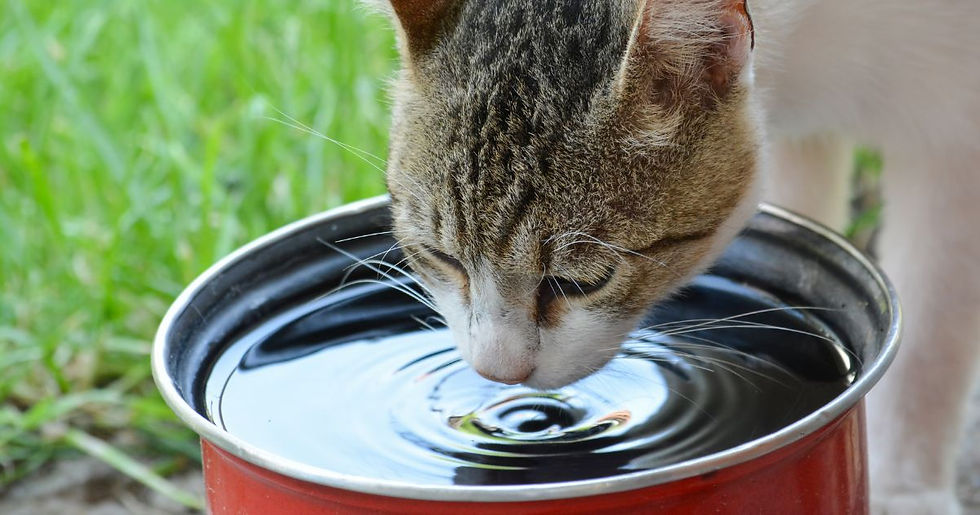Summer at Home: Creating a Cool Environment for Elderly Pets
- Dr. Emma Clark

- Jul 28
- 4 min read

For senior pets, staying cool during hot weather isn’t just about comfort—it’s essential for their health and safety. Older animals are more sensitive to heat due to reduced mobility, declining thermoregulation, and chronic health conditions. While it's tempting to focus on outdoor activity precautions, many pets spend most of their time indoors, where rising temperatures can be just as dangerous.
This guide offers practical tips for transforming your home into a cool, safe haven for elderly pets during the warmer months—supporting their comfort, wellbeing, and dignity.
Contents
Why Indoor Heat Can Be Harmful
Unlike younger animals, senior pets have less ability to adapt to rising temperatures. Thick coats, slower movement, and medical conditions like arthritis, heart disease, or kidney problems make them more vulnerable to overheating—even indoors.
Heat trapped in homes with poor airflow or sun-facing windows can quickly elevate room temperatures beyond what’s safe. Senior pets that spend much of their time sleeping or resting in one area may not realise—or be able to escape—when that spot becomes too warm.
Recognising indoor heat as a potential hazard is the first step in protecting your ageing pet.
Improving Airflow and Ventilation
Good ventilation is key to keeping your home cool and your pet comfortable. Stale, still air makes it harder for body heat to dissipate—particularly for pets who already struggle with thermoregulation.
Open windows during cooler hours: Early morning and late evening are ideal for safely circulating fresh air.
Use fans: While fans don’t lower temperature, they enhance evaporative cooling (especially if your pet is dampened). Place fans near resting areas, ensuring cords and blades are out of reach.
Cross-ventilation: Open windows or doors on opposite sides of your home to create airflow through rooms.
Limit appliance use: Ovens, dryers, and electronics contribute to indoor heat—minimise their use during hot periods.
Aim to maintain a calm, breezy environment throughout the day, particularly in rooms where your pet prefers to rest.
Choosing the Right Flooring: Tiles vs Carpet
Flooring makes a significant difference in how heat is retained or released in your home. Senior pets often spend hours lying down, so choosing a suitable surface can improve their comfort and reduce overheating risk.
Tiles, laminate, or hardwood floors: These remain cooler underfoot (or underpaw) and are easier for pets to stretch out on during hot spells.
Carpets and rugs: These retain heat and can become uncomfortably warm, especially in rooms exposed to sun. If your pet prefers lying on carpet, consider placing a cooling mat or damp towel on top.
Pet-safe cooling mats: These gel-based or water-activated mats provide a cooler resting surface without refrigeration.
Monitor where your pet tends to lie and adapt that area with the best flooring available.
Using Blackout Curtains and Shade
Direct sunlight can quickly turn rooms into saunas, particularly those with large windows or south-facing exposure. Limiting sun penetration is one of the most effective ways to keep indoor temperatures stable.
Install blackout curtains or thermal blinds: These significantly reduce heat transfer through windows. Keep them closed during peak sun hours.
Use reflective film or temporary window coverings: For glass doors or skylights, these options can help deflect solar heat.
Move beds out of sunny spots: While pets may enjoy a sunny nap in winter, summer sunbeams can be dangerous for older pets who may not realise they’re too hot.
Controlling indoor light and shade levels gives your pet more temperature-regulated areas to rest comfortably.
Creating and Rotating Cool Resting Areas
Older pets often have preferred spots to sleep or relax. In summer, these may need to be re-evaluated to ensure they’re not becoming heat traps.
Set up multiple beds: Offer a few choices around the home—ideally in different rooms and on different surfaces.
Rotate bed positions: Move beds to the shadiest or coolest parts of the house as the sun shifts during the day.
Keep bedding minimal: Avoid thick duvets or fleece blankets. Use light, breathable materials or cooling pads.
Add raised beds: Elevating your pet allows air to circulate beneath them, which can help keep them cooler, especially in rooms with hard floors.
Encourage relocation: Gently guide your pet to cooler areas if you notice them overheating or panting while resting.
Giving your pet options empowers them to choose what feels most comfortable at different times of day.
FAQs
Is it better to leave windows open all day?
Not always. During peak heat, open windows can let in hot air. It’s best to ventilate during early morning and evening hours, then keep windows shaded or partially closed mid-day.
What if my pet insists on lying on carpet?
Try placing a cooling mat or lightly damp towel on their favourite spot. Encourage them gently to use cooler areas, but don’t force a change unless they’re at risk.
Do cooling mats need to be refrigerated?
Most pet-safe cooling mats work via pressure-activated gel or water absorption and don’t require refrigeration. Check the manufacturer’s instructions for specifics.
My dog has arthritis—should I avoid hard flooring?
Tile or laminate is fine when paired with thin, non-slip mats. Avoid slippery surfaces but don’t opt for thick bedding that retains heat.















